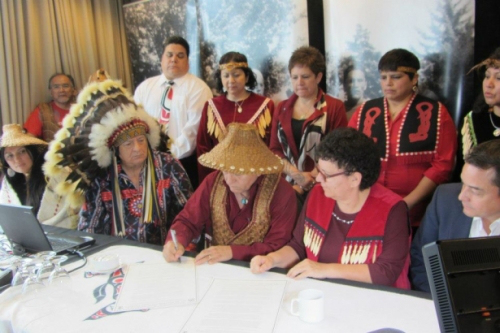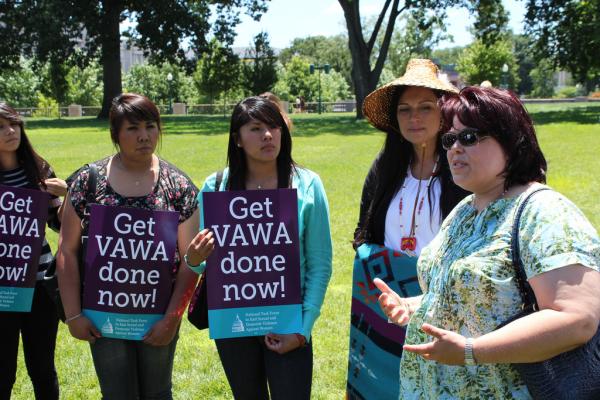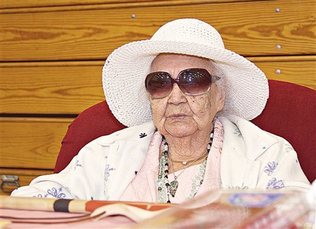Author: Kim Kalliber
Oglala Sioux vow to stop Keystone XL on the ground if Obama won’t say no

By Erin Flegg, Source: Vancouver Observer
In the latest in a series of announcements escalating resistance to oil and gas development in North America, the Oglala Sioux nation and its allies have committed to stopping the construction of the Keystone XL pipeline on their territory if Obama approves the project.
In response to the US State Department’s environmental report that says Keystone wouldn’t increase the country’s carbon emissions Oglala Sioux president Bryan Brewer, along with organizations carbon emissions, Owe Aku and Protect the Sacred, released a statement declaring they will stand with the Lakota people to block the pipeline. The statement, seen by many as a significant step toward approval, sparked solidarity action across the US on Monday.
Moccasins on the Ground is a grassroots direct action training organization, and trainer Debra White Plum of the Lakota Sioux nation said the group has been working toward this moment, giving nations the skills they need to defend their land, for years now.
The training is available to anyone who invites the group onto their land, and it consists of four days of training in areas such as knowing your rights, blockading and self-defence, first aid and social media. White Plume said a large part of the impetus for offering the training is the size of the territory at risk. Tribes can be several hundred kilometres away from each other, often making quick help hard to come by.
“This way a community can do whatever they need to do when threatened and they’ll have the skills right here, and that’s really important out here where we live,” she said. “We want this non-violent, direct way that everybody engaging in across the country to be successful,” she said. “But if it’s not and if the final door is closed, then that’s why we’re doing the training.”
The organization has toured the United States and has received requests for training from several nations in Canada. She said the political process has left the people with little choice.
“Every door has been closed through this process. Court decisions have been made that favoured the corporations and there are a few cases here and there where the landowners are still asserting their rights under American law.” But if the government can’t be counted on to uphold its own laws, she said, there’s nothing to stop them violating indigenous treaty rights.
“As red nations people we have seen the federal government violate treaties clear to this day.”
The violation of the treaties—in the case of Keystone it’s primarily the Fort Laramie Treaty between the American government and the Oglala Sioux—is the key reason Phil Lane says it’s unfair to call direct action by indigenous people civil disobedience.
“It is not civil disobedience. This is simply acting out of an aboriginal legal order to stand up for what is right. It is standing up for an ancient aboriginal legal order that has never been extinguished.”
Just as the US and Canada and any other sovereign nation has the right to enter into legally binding treaties, so do First Nations. When a treaty such as the one between the Sioux and the American government is broken by one of the parties bound by it, Lane said a third legal party is required to resolve the situation. Because the governments of the United States and Canada are handling the administration of the treaties they themselves have broken, Lane said it’s impossible to expect justice from them.
What direct action resistance against Keystone looks like will ultimately be up to the Obama administration.
“What’s going to happen if he chooses to give in to the oil companies and their allies is he’s going to empower the rising of indigenous people everywhere on Mother Earth,” he said. “This will be another final violation people aren’t ready to take.”
Ottawa-based Idle No More organizer Clayton Thomas-Muller added that it’s crucial to remember that opposition to Keystone XL was initiated and pushed forward by indigenous people. And what’s more, that much of the progress made has been thanks to the indigenous peoples who have demanded recognition of their rights, namely consultation.
In December of 2011 at the annual White House Tribal Leaders Summit, indigenous leaders, including former president of the Rosebud Sioux nation Rodney Bordeaux, presented President Obama with Mother Earth Accord, a document stating indigenous opposition to Keystone XL. The document was endorsed by numerous nations from both sides of the border, NGOs, landowners and the NDP party. Thomas-Muller said it’s the only such document that was delivered into Obama’s hands directly.
“It was only through native rights-based framework being used by indigenous organizations and networks that provide that unparalleled access to the state department and White House,” he said.
He traveled to New York City on Monday night to speak at one of more than 300 actions across 44 states this week. He read a statement written by Debra White Plume and spoke on behalf of Idle No More in Canada.
So many people have been preparing for this moment, he said, and are now coming together for a final push.
“Moving forward, we have a very short timeline. Within the next couple of months we will see a variety of very direct messages like the one we heard from Bryan Brewer of Oglala Sioux nation.”
Ballots must be returned by Feb. 11
Source: Marysville Globe
Local voters still have time to fill out and return their ballots for the Feb. 11 Special Election.
Voters in the Marysville School District are being asked to vote on two levies.
Proposition 1 is a replacement Educational Programs Maintenance and Operations Levy and Proposition 2 is a new Technology Levy.
Voters in the Lakewood School District are being asked to vote on Proposition 1, a bond to renovate Lakewood High School.
Ballots returned by mail must be postmarked by Feb. 11. Ballots can also be dropped off at ballot drop boxes. Drop boxes are available until 8 p.m. on Election Day, Feb. 11.
Ballot drop boxes are located in Arlington at 135 N. Washington Ave. (near the library), and in Marysville at 1015 State St. (behind the Municipal Court).
For more information, go to the Shonomish County Elections website at www1.co.snohomish.wa.us/Departments/Auditor/Divisions/Elections_Voting.
Frustration Surrounds New Tribal Labor Force Report
Is the 2013 Indian Population and Labor Force Report making anyone happy?
Tribal leaders and citizens have yet to say whether they are gaining anything useful from the report, which was issued in January after a long delay by the Obama Administration over apparent data collection problems.
The 151-page Bureau of Indian Affairs (BIA) document includes a lot of data. It generally says that there is a lot of poverty on many reservations, many Indians work for tribal, state or federal governments, and Native youth are especially having trouble finding jobs.
RELATED: Finally! Indian Country Gets Its Labor Force Report
It says precious little about what is working for some tribes, and how other tribes can copy the success stories. And it provides no data on how federal American Recovery and Reinvestment Act (ARRA) investments in tribal reservations in 2009 and beyond actually impacted Native employment, and whether there were lasting economic impacts that would call for greater federal investment in certain areas. Congressional leaders who lambasted the lateness of the report in summer 2012 had hoped that when it was eventually released that it would at least provide a little insight on how ARRA worked—or didn’t work—for struggling tribes.
RELATED: Legal and Political Questions Surround Interior’s Decision Not to Release Tribal Jobs Survey
With roots going back to 1982, the report is supposed to be a tool for both tribes and Congress, depicting the labor and employment landscape across a wide range of tribes facing a multitude of economic situations.
Congressional supporters of the rationale for the report say that tribes could ideally use the data, which is supposed to be issued every two years, to make fact-based quantitative arguments for improved federal and other assistance.
But that ideal situation is not happening, says Rep. Don Young (R-Alaska), chair of the Subcommittee on Indian and Alaska Native Affairs, and he does not think it is likely to happen given the new data in the current report.
“The 2013 Indian Population and Labor Force Report recently released by the Bureau of Indian Affairs is far from a helpful document,” Young tells Indian Country Today Media Network. “In reality, this document has more potential to cause harm than good. What was published is essentially a reprint of unhelpful and outdated U.S. Census Bureau data, all of which was publically available prior to the release of the report.” Young notes the failings of Census Bureau data collection, including the miscounting and undercounting of thousands of Alaska Natives and American Indians, are already well known.
“From what I’ve seen, the report contains huge gaps in data for many parts of Indian country and relies heavily on making estimates about tribes’ economic circumstances,” Young adds. “Additionally, the report’s labor and employment statistics are not accurate metrics for providing a realistic picture of the actual circumstances in Native communities.” Young believes that Alaska Native and American Indian communities will actually suffer if agencies use this report for making policy decisions or determining how best to allocate federal resources meant to support programs in Indian country.
Young’s view is representative of other Congress members focused on Indian affairs who want the report to be doing more than the current one. Retired Sen. Daniel Akaka (D-Hawaii) echoed Young’s concerns in July 2012 when the report was gaining attention for being long overdue. “It is crucial to have an accurate record of employment statistics in order to best assess need and to appropriate financial resources to tribes,” Akaka then said. “Understanding the current economic outlook will better help us to put forth legislation that will increase economic development and job creation in Indian country.”
RELATED: Congress Investigating Interior on Missing Tribal Job Reports That Broke Law
One of the reasons the BIA cited for the long delay surrounding the current report – the last of which highlighted 2005 tribal data—is that they wanted it to be better than previous ones. “When we are able to release something, I am confident that it will be far more accurate than any report we’ve ever released before on this issue,” Assistant Secretary-Indian Affairs Kevin Washburn told ICTMN in August 2013 when asked why the report still had not been released.
The new report may be more accurate, but it is still a source of frustration, BIA leadership concedes.
“Our economist did the best he could with imperfect data,” Washburn says. “We are neither the U.S. Census Bureau, nor the Bureau of Labor Statistics. Those agencies both exist and we do not believe Indian country wants us to become them. We are not a statistical agency. Our primary mission is to provide services to tribes.”
Washburn, hearing the critiques of Young, says it was a tough situation. “We hired [the economist] to help Indian Affairs make more accurate (and therefore hopefully more compelling) budget submissions to Congress,” he says. “However, the economist was hijacked from this equally important task and reassigned to help with the labor force and population report in hopes of making it more accurate than in the past.”
On why the ARRA tribal outlook was not covered in the report, Washburn cites the limited resources of his agency. “The fact is that we had only one economist working on this, and I believe that it would have taken a battery of economists to produce an analysis of all the effects of ARRA,”’ he says. “It was hard enough simply trying to gather the labor and population data for 566 tribes in twelve BIA regions. Moreover, the requirement for the report was enacted with the 477 law, many years before ARRA. The data was not intended to show anything about ARRA. The report simply has no relation to ARRA.”
Washburn also suggests that Congress should re-evaluate whether it is wise to have the BIA and, in turn, tribes shoulder the costs of this biannual report. “A tribal administrator with the Citizen Band of Potawatomi told me in a public meeting that it would cost her tribe $500,000 to do everything the tribe needs to do to accurately report labor and employment data for this report,” he says. “That is one out of 566 tribes. I do not feel that the 477 law was intended to impose such costs on tribes.
Washburn also says he doubts that Congress intended the BIA to bear such costs, but he adds that his agency plans to issue the next report on time, in accordance with the law.
Read more at http://indiancountrytodaymedianetwork.com/2014/02/07/frustration-surrounds-new-tribal-labor-force-report-153463
Documentary About Hoopster Shoni Schimmel Among iTunes’ Top Downloads
Off the Rez, a 2011 documentary about Umatilla basketball star Shoni Schimmel, is putting up respectable download numbers at Apple’s iTunes store. As of this writing, the film is at no. 99 on the overall iTunes Top 100 list, and is the seventh-highest ranked documentary.
Click here to go to the Off the Rez page at iTunes.
Schimmel is now a force on the court for the University of Louisville (where her sister Jude is also on the team), and was recently spotlighted by ESPNW as the college player of the week. Off the Rez premiered at the Tribeca Film Festival in 2011, and aired on cable TV as Shoni’s Louisville Cardinals were making their run to the NCAA tournament finals in 2013.
Below are a few clips from Off the Rez; many more can be seen at director Jonathan Hock’s Youtube channel.
Read more at http://indiancountrytodaymedianetwork.com/2014/02/06/documentary-about-hoopster-shoni-schimmel-among-itunes-top-downloads-153448
Cladoosby Hopes to Initiate Repatriation Discussion With France

Swinomish Chairman Brian Cladoosby introduces President Obama as the “first American Indian president” of the U.S., at the 2012 White House Tribal Nations Conference. Cladoosby and his wife will be the Obamas’ guests at the White House State Dinner for French President Francois Hollande, February 11.
National Congress of American Indians President Brian Cladoosby doesn’t expect he’ll have more than an opportunity to shake the hand of French President Francois Hollande at a White House state dinner February 11.
But he hopes that introduction will open the door to negotiation of an agreement for the repatriation of Native American objects in French museums.
Cladoosby, chairman of the Swinomish Tribe, and his wife Nina were invited by President Barack Obama and Mrs. Obama to the state dinner being held in honor of the French president.
During the French president’s visit to the U.S., Obama and Hollande “will discuss opportunities to further strengthen the U.S.-France security and economic partnership,” Obama said in a statement posted on www.whitehouse.gov.
“Michelle and I look forward to welcoming President Hollande … on a state visit to the United States,” Obama said.
“The United States and France are close friends and allies, including through NATO, and our countries have worked together to support democracy, liberty, and freedom at home and abroad for more than two centuries.”
The state dinner comes two months after a French judge’s decision to allow an auction house in Paris to sell 24 sacred Native American artifacts, despite the protests of the Hopi Nation, the U.S. Embassy, and indigenous civil rights organization Survival International.
RELATED: Sad But True: Another Hopi Katsinam Auction Planned in Paris
The Annenberg Foundation intervened, submitting a winning bid of $530,000 U.S. for the sole purpose of returning the objects to their rightful owners – 21 items belong to the Hopi Nation, three to the San Carlos Apache.
RELATED: Surprise! Charity Buys 21 Sacred Katsinam for Hopi at Auction in Paris
The Native American Graves Protection and Repatriation Act gives indigenous nations in the U.S. a way to reclaim funerary objects and ceremonial items from federal agencies and museums in the United States. The law, however, does not apply to items held internationally.
Christopher Marinello, executive director and general counsel of Art Loss Register London, the world’s largest private database of lost and stolen art, antiques and collectables, told ICTMN in April 2013 that the Hopi and Apache objects should have been repatriated under the 1970 UNESCO Convention on the Means of Prohibiting and Preventing the Illicit Import, Export and Transfer of Ownership of Cultural Property. France ratified the convention in 1997.
RELATED: Hopi Katsinam and Nazi Art Theft: An Expert Discusses Principles of Repatriation
According to the convention, “the [Hopi and Apache] pieces should have been pulled off, parties should have had a discussion to see which pieces could be sold, which were not genuine, what were the moral claims, what was important to the tribe, what is the compensation,” Marinello told ICTMN.
Marinello said there are no international agreements specifically addressing Native American artifacts, and said “it is something that the Americans should be convening and discussing because the laws in the USA protecting those Native artifacts have no weight overseas.”
That’s what Cladoosby hopes to initiate, noting, “We want to ensure our most sacred items are treated the same way” as those covered by other repatriation conventions.
Read more at http://indiancountrytodaymedianetwork.com/2014/02/07/cladoosby-hopes-initiate-repatriation-discussion-france-153409
Three Tribes to Begin Prosecuting Non-Indian Domestic Violence Offenders
Three pilot tribes have been chosen by the Obama Administration to take early advantage of Violence Against Women Act (VAWA) provisions passed by Congress last year that allow tribes to prosecute non-Indian offenders for domestic violence offenses on reservations.
The Justice Department announced February 6 that the Pascua Yaqui Tribe of Arizona, the Tulalip Tribes of Washington, and the Umatilla Tribes of Oregon will be the first in the nation to be able to exercise criminal jurisdiction over certain crimes of domestic and dating violence, regardless of the defendant’s Indian or non-Indian status, under the 2013 VAWA law.
“Our actions today mark a historic turning point,” Associate Attorney General Tony West said in a press release announcing the decision. “We believe that by certifying certain tribes to exercise jurisdiction over these crimes, we will help decrease domestic and dating violence in Indian country, strengthen tribal capacity to administer justice and control crime, and ensure that perpetrators of sexual violence are held accountable for their criminal behavior.”
Beyond this pilot required by Congress, the law allows increased tribal jurisdiction to go into effect for all tribes in the lower 48 states in March 2015. Tribes at that time will not need Justice Department approval if they meet provisions of the law required for enhanced jurisdiction over domestic and dating violence cases.
Justice officials said West chose the three tribes for pilot participation because their tribal court systems have adequate safeguards in place to fully protect defendants’ rights under the Indian Civil Rights Act of 1968. They further said the decision to choose the three tribes were based on reviews of application questionnaires submitted by the tribes in December 2013, along with excerpts of tribal laws and policies.
“The Tulalip Tribes is honored to be among those chosen for the Special Domestic Violence Criminal Jurisdiction pilot program,” Tulalip Chairman Mel Sheldon said in a press release. “Getting justice for our tribal members, where it concerns domestic and intimate partner violence, has been a long time coming.”
“This is very positive news for tribes,” added Troy Eid, the recent chair of the Tribal Law and Order Commission who is scheduled to testify on VAWA and other tribal justice issues before the Senate Committee on Indian Affairs February 12. “It’s wonderful to see that three were approved, and the hope is that the other tribes that submitted applications are getting strong assistance from the Department of Justice to get up and running very soon.”
Six tribes in total have applied so far to participate in the pilot project, according to the National Congress of American Indians. The three that applied that that were not approved on February 6 are still under review, said Wyn Hornbuckle, a spokesman for Justice; they are the Assiniboine and Sioux Tribes of the Fort Peck Indian Reservation, the Penobscot Indian Nation, and the Ute Indian Tribe of the Uintah and Ouray Reservation. Tribal justice advocates say Justice has shown a willingness to work with the tribes to help them be able to take part in the law, and Hornbuckle said tribes may submit applications to participate in the pilot project any time before March 7, 2015. Some tribes were opposed to the pilot portion of the law, believing they should have been given immediate increased jurisdiction upon passage of the law, but the pilot was a compromise between Senate and House legislators added into the law in 2013 so that it could gain enough support to be approved by both chambers.
Once the full law goes into effect in 2015, Eid predicts many people will be asking why tribes were not trusted for so long. “The idea that local governments should have jurisdiction over these kinds of offenses is a basic bedrock principle of the American justice system,” he says. “There is no reason for tribes not to have this local control, as do all other local communities.”
Before the 1978 Supreme Court decision opinion in Oliphant v. Suquamish Indian Tribe, federally recognized tribes were widely able to exercise criminal jurisdiction over non-Indian defendants. Since that decision, which severely limited tribal sovereignty, tribes and the federal government have documented large amounts of domestic violence and dating violence committed by non-Indian abusers, yet tribes have not been able to prosecute these offenders, and the federal government has been slow to curb the problem with its own justice system.
In conjunction with the announcement, administration officials cited on the White House blog a recent study by the Centers for Disease Control and Prevention that found 46 percent of Native American women have experienced rape, physical violence, and/or stalking by an intimate partner in their lifetime.
Tribal leaders and advocates spent much of 2012 and 2013 pushing for tribal jurisdictional provisions to be restored in the VAWA reauthorization against intense Republican opposition. After a prolonged battle in Congress, they were finally successful when the reauthorization was signed into law by President Barack Obama in March 2013.
RELATED: President Barack Obama’s VAWA Law Signing Spotlights Native Women Warriors
“We lift our hands to all those who fought for the reauthorization of the Violence Against Women Act, including our own Tulalip Tribes councilwoman, Deborah Parker,” Sheldon added.
Alaska Natives, meanwhile, are currently waging a campaign for passage of a congressional VAWA fix that would give their tribal communities jurisdiction over similar domestic and dating offenses. Sens. Lisa Murkowski (R-Alaska) and Mark Begich (D-Alaska) have introduced legislation called the Safe Families and Communities Act, which does not go nearly as far as the 2013 VAWA law in increasing tribal jurisdiction over non-Indian domestic violence and dating offenders.
Alaska Natives are pressuring Begich, who is in a close re-election race, to support a congressional fix that will treat Alaska Native communities the same as tribes in the rest of the country on jurisdictional matters. Alaska Native tribes make up 40 percent of all federally recognized tribes.
Read more at http://indiancountrytodaymedianetwork.com/2014/02/06/three-tribes-begin-prosecuting-non-indian-domestic-violence-offenders-153449
Last Native Klallam Speaker Dies in Port Angeles
Source: ABC News; Information from: Peninsula Daily News, http://www.peninsuladailynews.com
The last person to have spoken the Klallam language from birth and the eldest member among the Klallam American Indian tribes of the Pacific Northwest has died in Port Angeles at the age of 103, family and tribal members said.
Hazel M. Sampson was the last person who first learned Klallam, then learned English as a second language, said Lower Elwha Klallam tribal member Jamie Valadez, who teaches the Klallam language and culture at Port Angeles High School.
Her death on Tuesday changes the dynamics of the culture, Valadez told the Peninsula Daily News (http://bit.ly/1gQodE1) in a story Thursday.
“In the U.S., this is happening all over Indian Country,” Valadez said. “They carry so much knowledge of our culture and traditions. Then it’s gone.”
Valadez and Texas linguist Timothy Montler worked with Sampson and her husband, Ed, and other native speakers in the 1990s to compile a Klallam dictionary.
If Ed forgot a word or got it wrong, Hazel would come out of the kitchen and correct him, but she declined to be officially involved in the project, Valadez said.
Klallam is the language of three U.S. tribes: the Lower Elwha, Jamestown S’Klallam and Port Gamble S’Klallam, as well as the Beecher Bay Klallam in British Columbia. The three tribes on Washington’s Olympic Peninsula have a total of about 1,700 members, according to Census figures.
Sampson was born in the Jamestown S’Klallam band in 1910. Her grandfather was Lord James Balch, for whom Jamestown community near Sequim was named. She was married to Edward C. Sampson for 75 years until his death in 1995.
A private service will be held for family and close friends. No public memorial has been announced.
The Klallam are among a growing number of tribes trying to revitalize their languages, which in some cases are spoken by only a small handful of people. Linguists estimate about 200 Native American languages are spoken in the U.S. and Canada, with another 100 already extinct.
Montler developed a series of booklet guides and lessons in 1999 to help students learn the basics of the language through storytelling. The lessons are used in Klallam programs at Dry Creek Elementary, Stevens Middle and Port Angeles High schools, where the largest population of Klallam children are educated.
The Klallam dictionary was published by the University of Washington Press in 2012 and distributed to Klallam and S’Klallam families, local libraries and schools. The others who helped compile the dictionary have died.
Sampson’s death is a loss of not only her language knowledge, said Ron Allen, chairman of the Jamestown S’Klallam.
“She was a strong spirit representing who we are as a people,” he said.
———
Information from: Peninsula Daily News, http://www.peninsuladailynews.com
Beast Mode! Marshawn Lynch Beats Lummi Fan’s Drum in Seahawks Victory Parade
During the Super Bowl victory parade in downtown Seattle yesterday, running back Marshawn Lynch got the crowd’s attention.
As he rode in the WWII-era Duck vehicle, Seattle Seahawks’ running back Marshawn Lynch heard a fan beating on a drum. So, of course, he did what any normal football player would do, he asked if he could borrow it.
“As soon as he heard me beating the drum and he saw me, he turned around and looked right at me,” John Scott, 41, told The Bellingham Herald. “Our eye contact was immediate. He kept waving his hands and asking for (the drum).”
And, like any fan in the crowd would do, Scott handed it over.
RELATED This Could Get VERY Loud! 500,000 expected for Seahawks Parade
Columbia River Native Fish Shop Opens This Weekend
By Anna King, NW News Network
In the Northwest, Native Americans have caught and traded fish along the banks of the Columbia River for eons. Nowadays, natives sell just-caught fish out of coolers roadside.
This weekend, one native entrepreneur is opening her own brick-and-mortar fish shop in Cascade Locks, Ore,. called the Brigham Fish Market.
Kim Brigham Campbell is a petite woman with sleek black hair, razored just below her chin. And a laid-back, warm persona.
We walk past the clean, bright front counter to the room behind.
“In the back here we have our ice machine and our 20 by 20 freezer cooler,” she says.
“We’re getting a good variety [of fish]. There is our smoked fish, there are bellies and stuff for bait for sturgeon, there is sturgeon, we have some clam chowder that we are going to have on opening day, and more varieties of salmon.”
Bins of filets are all packaged up tight in glossy vacuum packs ready for sale.
From Brigham Campbell’s store you can see the Columbia River where these fish are plucked fresh from the chilly water. In this cooler is a precious half-year of hard work.
Brigham Campbell’s Native American family is well-known on the lower Columbia River. She’s a member of the Confederated Tribes of the Umatilla Reservation. Her father fishes, her uncles, her cousins, her sister, her children.
Brigham Campbell says her family name is tied to this store, and that means she’s had a few sleepless nights lately.
“I’ve been really comfortable building the building,” she says. “And now that it’s time to open the building, I hope that it’s everything that I want it to be and everything that people are expecting of me.”
To build the store, Brigham Campbell and her husband took out loans, cashed in a 401(k), struck a land deal with the nearby port and even borrowed money from her parents.
Brigham Campbell herself is a mother of two teenagers, an independent hairdresser and has managed to guide the construction of this new shop.
I ask her who she is most excited to see come through your the front doors.
“My parents, of course,” she says. “I’ll probably cry [when they walk through.] It will be a good thing.”
And getting to this opening hasn’t always been easy. There’s been some talk that she’s taking away from tradition, or changing things too much.
Still, she says many in her tribal community have been supportive.
“In the spring time, April or May I’m going to have a blessing,” says Brigham Campbell. “I’m going to have some drummers and singers come down and do a bigger grand opening. This is just my soft opening. I just need to open my doors. In the springtime I want to honor everyone that’s helped me and the blessing from the tribe.”
Blessing ceremonies for fishing families along the Columbia River isn’t new. For centuries Brigham Campbell’s ancestors prospered from the Northwest’s rivers and land.
With this bright new store, Brigham Campbell says she’s reasserting her belief in the Columbia River. That the wide waters will provide for her family’s future, as it has in the past.
The Brigham Fish Market opens in Cascade Locks, Oregon, at noon on Saturday, February 8.
















